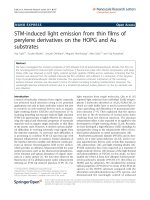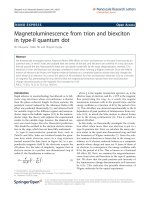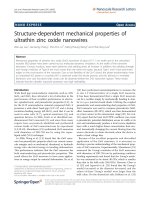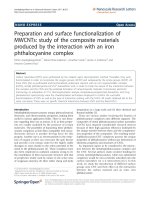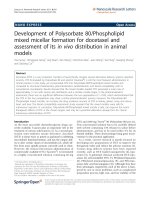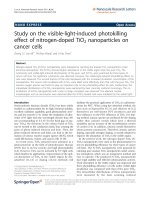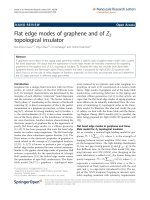Saterlie et al. Nanoscale Research Letters 2011, 6:217 pdf
Bạn đang xem bản rút gọn của tài liệu. Xem và tải ngay bản đầy đủ của tài liệu tại đây (538.6 KB, 7 trang )
NANO EXPRESS Open Access
Particle size effects in the thermal conductivity
enhancement of copper-based nanofluids
Michael Saterlie
1
, Huseyin Sahin
2
, Barkan Kavlicoglu
2
, Yanming Liu
2
, Olivia Graeve
1*
Abstract
We present an analysis of the dispersion characteristics and thermal conductivity performance of copper-based
nanofluids. The copper nanoparticles were prepared using a chemical reduction methodology in the presence of a
stabilizing surfactant, oleic acid or cetyl trimethylammonium bromide (CTAB). Nanofluids were prepared using
water as the base fluid with copper nanoparticle concentrations of 0.55 and 1.0 vol.%. A dispersing agent, sodium
dodecylbenzene sulfonate (SDBS), and subsequent ultrasonication was used to ensure homogenous dispersion of
the copper nanopowders in water. Particle size distribution of the copper nanoparticles in the base fluid was
determined by dynamic light scattering. We found that the 0.55 vol.% Cu nanofluids exhibited excellent dispersion
in the presence of SDBS. In addition, a dynamic thermal conductivity setup was developed and used to measure
the thermal conductivity performance of the nanofluids. The 0.55 vol.% Cu nanofluids exhibited a thermal
conductivity enhancement of approximately 22%. In the case of the nanofluids prepared from the powders
synthesized in the presence of CTAB, the enhancement was approximately 48% over the base fluid for the 1.0 vol.
% Cu nanofluids, which is higher than the enhancement values found in the literature. These results can be
directly rela ted to the particle/agglomerate size of the copper nanoparticles in water, as determined from dynamic
light scattering.
Background
It is well-known that the thermal conductivity of fluids,
such as water or ethylene glycol, can be enhanced
through the addition of nanoparticles. These two-com-
ponent systems have effective thermal conductivities
that include the thermal conductivity o f the pure mate-
rials, t he composition of the mixture, and the shape of
the dispersed particles, as follows [1]:
K = K
1
·
K
2
+
(
n − 1
)
· K
1
−
(
n − 1
)
· V
2
·
(
K
1
− K
2
)
K
2
+
(
n − 1
)
· K
1
+ V
2
·
(
K
1
− K
2
)
(1)
in whic h K, K
1
,andK
2
are the thermal conductivities
of the nanofluid, the dispersed phase, and the base fluid,
respectively, n is an empirical shape factor dependent
on the sphericity of the particles, and V
2
is the volume
fraction of the particles. This model includes the effect
of particle shape and size and has been applied to a cop-
per/water nanofluid system with three different spheri-
city factors, showing that the thermal conductivity of a
nanofluid depends on both the particle volume fraction
and the shape [2].
A comparison of particle shape in SiC nanofluids of
water and ethylene glycol has been completed with pow-
ders of spherical morphology of 26-nm average crystal-
lite size and cylindrical morphology of 600-nm average
crystallite size along the fiber axis direction [3]. It was
concluded that because heat transfer occurs between the
surface of the particles and the fluid, heat transfer is
more efficient for a system with a larger interfacial area.
Therefore, smaller crystallites will exhibit the greatest
amount of thermal conductivity enh ancement. However,
this conclusion does not t ake into consideration the
effect of agglomeration of the powders in the fluid. If
the powders are heavily agglomerated, then heat transfer
is possibly hindered, since transfer will only occur on
the surfaces of the agglomerates, even if the powder
crystallite sizes are in the nanometer range.
In nanof luids of Al
2
O
3
/water, an increase of 12% in
thermal conductivity enhancemen t was o bserved wit h
the addition of Al
2
O
3
powders with crystallites of 28-nm
average size at a particle volume fraction of 3% [4]. Other
studies of this same system, with powders of 13 and
* Correspondence:
1
Kazuo Inamori School of Engineering, Alfred University, 2 Pine Street, Alfred,
NY 14802, USA.
Full list of author information is available at the end of the article
Saterlie et al. Nanoscale Research Letters 2011, 6:217
/>© 2011 Saterlie et al; licensee Spri nger. This is an Open Access article distributed under the terms of the Creative Commons Attribution
License (http://c reativecommons.org/licenses/by/2.0) , whic h permits unrestricted use, distribution, and reproduction in any medium,
provided the or iginal work is properly cite d.
38 nm Al
2
O
3
average crystallite size exhibited a 20% and
8% thermal conductivity enhancem ent [5,6]. The e ffect
can be attribut ed to the phonon mean free path in the
nanofluid [7] such that in a nan ofluid containing nano-
particles of a crystallite size much different from the pho-
non mean free path, the thermal conductivity will
increase with decreasing crystallite size, while in a nano-
fluid containing nanoparticles less than or equal to the
mean free path, the thermal conduc tivity will be red uced
with crystallite size reduction due to the scattering of
phonons. None of these studies reported the l evel of
agglomeration (i.e., the s ize of the particle/agglomerates)
in the nanofluid. Since powders tend to heavily agglomer-
ate in polar fluids, a comparison connected to the
agglomeration of the particles and not just to crystallite
size, canno t be a scertained without p roper part icle/
agglomerate size distribution analysis [8-14].
Table 1 summarizes results on crystallite and particle
sizes, if report ed, of several copper-based nanofluids. Of
the studies that incorporated particle size distribution
analysis, only Sinha et al. [8] and Wang et al. [15] pro-
vided a complete description of instrumental parameters
for analysis of the particle size distribution in the fluids.
The Cu/and Fe/ethylene glycol nanofluids from Sin ha et
al. [8] exhibited particle sizes of 400-600 nm. In the
investigation by Wang et al. [15] , the particle size
average for the fluids prepared without sodium dodecyl-
benzene sulfonate (SDBS) as dispersant was greater than
1 μm, while the fluids with SDBS exhibited a particle
size average around 200 nm.
In this study, we prepared copper nanopowders and
then incorporated these powders into water, with SDBS
as a dispersant, for the formation of well-dispersed
nanofluids. The copper nanoparticles were produced
through the reduction of copper (II) chloride with
sodium borohydride in the presence of a surfactant [i.e.,
oleic acid or cetyl trimethylammonium bromide
(CTAB)]. After preparation of powders using various
surfactant concentrations, the optimal samples were
chosen based on pha se and parti cle size criteria. The
small agglomerate sizes for the 0.55 and 1.0 vol.% cop-
per nanofluids exhibited thermal conductivity e nhance-
ments of up to 48% over the base fluid with a mean
thermal conductivity of 0.89 W/m·K, higher than the
enhancement values found in other studies, as will be
discussed later. We conclude that minimization of
agglomerate size in nanofluids is important in order to
take full advantage of the presence of nanopowders i n
the base fluid.
The main experimental result and contribution of this
work to the nanofluid field is that excessive aggregat ion
of the dispersed phase reduces the effectiveness of the
produced na nofluid through the settl ing of particles and
disruption of nanofluid flow during thermal conductivity
testing. While this has been hypothesized extensively,
our work shows definite experimental results to support
this. When testing the thermal conductivity of the nano-
fluids, the increase in particle loading for the oleic acid
powders from 0.55 to 1.0 vol.%, results in rapid settling
due to increased agglomer atio n, as carefully determined
by dynamic light scattering measurements.
Experimental methodology
The copper nanoparticles were synthesized using a che-
mical precipitation technique using a custom benchtop
reactor system. Two separate aqueou s solutions contain-
ing the precursors were prepared and subsequently
mixed inside the reactor. A mass of 16.10 g of copper (II)
chloride (99+%, Alfa Aesar, Ward Hill, MA, USA) was
added to 80 mL of de-ionized water under constant stir-
ring. After 30 min of stirring, a surfactan t was added and
allowed to mix int o the aqueous metal sal t solution. Two
different surfactants were tested. Oleic acid (MP Biome-
dical LLC, Solon, OH, USA) and CTAB (high purity
grade, AMRESCO Inc., Solon, OH, USA) exhibit very dif-
ferent capping characteristics and were chosen because of
their successful stabilization of metal nanoparticles in a
variety of studies [18,22-31]. Various amounts of the two
surfactants were added to the aqueous copper salt solu-
tion to observe the effect of surfactant concentration on
Table 1 Crystallite and particle size results in copper-based nanofluids
Material Dispersant Crystallite size (nm) Particle size (nm) Reference
Cu prepared using oleic acid SDBS 15-45 120-200 This study
Cu prepared using CTAB SDBS 10-37 60-100 This study
Cu None 30-40 400-500 Sinha et al. [8]
Cu None, SDBS 25 ~5,500; ~150 Wang et al. [15]
Cu None 50-100 Not reported Liu et al. [16]
Cu None 10 Not reported Eastman et al. [17]
Cu None 100 Not reported Xuan and Li [18]
Cu None 25-30 Not reported Velasco et al. [19]
Cu None, SDBS 25-60 5,560; 130 Li et al. [20]
Cu PVP 5-10 Not reported Yu et al. [21]
Saterlie et al. Nanoscale Research Letters 2011, 6:217
/>Page 2 of 7
particle size and oxidation protection in the final nano-
fluids. For the optimized nanofluids tested for thermal
conductivity, the amounts were 1.67 g of oleic acid and
0.57 g of CTAB. Separately, 11.86 g of sodium borohy-
dride (98%, Alfa Aesar, Ward Hill, MA, USA) were dis-
solved in 220 mL of de-ionized water. To prevent
hydrolysis of the reductant solution, the pH of the boro-
hydride solution was maintained at 11-12 through the
addition of 2 M sodium hydro xide (98%, Alfa Aesar,
Ward Hill, MA, USA). The reductant solution was then
added into the reactor under vigorous stirring with nitro-
gen purging for 5-10 min. The aqueous salt solution was
subsequently added under constant stirring. A vigorous
reaction, with temperatures in e xcess o f 75°C, was
observed as the copper ions were re duced to metal under
the following reaction:
Cu
2+
(
aq
)
+2·
(
BH
4
)
−
+6H
2
O −→ Cu ↓ +2H
3
BO
3
+7H
2
Due to the rapid release of hydrogen during the reac-
tion and the presence of bubbling n itrogen gas, signifi-
cant foam was formed upon reduction of the copper
salt/surfactant solution. To counteract this foaming,
octyl aldehyde (98%, Sigma Aldrich, St. Louis, MO,
USA), a known de-foaming agent, was added as needed
throughout the process.
Once the reaction was complete, the fluid was
removed from the reactor, emptied into 50-mL centri-
fuge tubes, and centrifuged using an Eppendorf Centri-
fuge 5810 (Eppendorf, Hamburg, Germany 22339) for
10 min at 11,000 rpm. The clear supernatant liquid was
discarded and a solution of 50/50 semiconductor grade
methanol (99.9%, Alfa Aesar, Ward Hill, MA 01835,
USA) and de-ionized water was added to the centrifuge
tubes in order to remove sodium chloride and the sur-
factant from the surfaces of the particles. These tubes
were shaken vigorously for 5 min. A second methanol/
water wash and a final methanol wash were applied o n
the powders while d ecanting the supernatant after each
centrifugation. The copper powders we re then placed in
a vacuum dessicator for 2 to 3 days. Once dry, the pow-
ders were ground by hand using a mortar and pestle.
In later experiments, the batch sizes were increased.
This required one solution to contain 67.08 g of CuCl
2
in 200 mL of de-ionized water and a separate solution
of 148.86 g of sodium borohydride in 300 mL of de-
ionized water. The same molar ratios for the surfactants
were used for the production of the larger batch sizes,
resulting in amounts of 6.94 g of oleic acid and 1.29 g
of CTAB.
Two different nanofluids , of 0.55 and 1.0 vol.% co pper
concentrations in water, were prepared. For preparation
of the 0.55 vol.% copper nanofluid with 15 wt.% disper-
sant, 2.61 g of SDBS (Sigma Aldrich, St. Louis, MO,
USA) was added to 296 mL of de-ionized water and
allowed to s tir at a slow speed, so that a high shearing
force did not result in bubbles on the surface. A mass of
14.78 g of copper powder was then slowly added to the
dispersant solution under slow stirring and allowed to
mix for 1 h. The 1.0 vol.% copper nanofluid contained
4.74 g of SDBS and 26.88 g of copper powder in
292 mL of de-ionized w ater. The fluid was transferred
to a jacketed reaction vessel and then ultrasonicated
using an Ultrasoni c Pro cessor (Ace Glass, Vineland, NJ,
USA) for 50 min with amplitude of 70%, pulsed on for
3 s, then off for 3 s.
Particle size measurements were performed on a
Microtrac Nanotrac Ultra dynamic light scattering sys-
tem (Microtrac Inc., Montgomeryville, PA, USA). The
Microtrac Nanotrac Ultra instrument measures the par-
ticle size distribution in solution, with measur ement
capability from 0.8 nm to 6.5 μm. Multiple measure-
ments were done on each sample, using the appropriate
parameters determined by the estimated particle size
range and fluid visco sity. With these paramet ers, the
measurements were taken at a run time of 30 s. At least
five measurements were taken for each sample and then
averaged to produce accurate particle size distribution
analysis for each sample as is recommended by the
instrument manufacturer and in conjunction wit h
ASTM standard E2490-09.
A commercially available liquid computer cooling sys-
tem [ 32] was retrofitted with instrumentation in order
to evalu ate the thermal performance of the nanofluid, as
showninFigure1(a).Thiscooling unit consists of a
pump, radiator, cooler fan, refill reservoir, and cold
plate. Validation and calibration of the instrument was
completed by testing the thermal conductivity of de-
ionized water and comparing the output with expected
thermal conductivity data. In order to eliminate settling
of the nanoparticles in the reservoir, a mixer, illustrated
in Figure 1(b), was ad ded to the experimental setup. Up
to 200,000 cycles were continuously tested using our
dynamic experimental setup. Experimental results show
that the change in thermal conductivity of the nanofluid
over the entire test (i.e., 200,000 cycles) is less than 1%,
thus, our system is highly accurate.
Results and discussion
Particle size distributions for the 0.55 and 1 vol.% cop-
per nanofluids are displayed in Figure 2. The formation
of such small agglomerates, ~120 and ~ 80 nm on aver-
age for the oleic acid- and CTAB-prepared powders,
respectively, at a particle loading of 0.55 vol.%, is ideal
for the production of effective nanofluids that can exhi-
bit excellent dispersion stability. Smaller agglomerate s
will stay dispersed within the fluid for a much longer
period of time over that of larger, micrometer-sized
Saterlie et al. Nanoscale Research Letters 2011, 6:217
/>Page 3 of 7
agglomerates. When increasing the nanoparticle l oading
to 1.0 vol.%, the nanofluids of oleic acid-prepared pow-
ders become heavily agglomerated, increasing the parti-
clesizefrom120to800nm.Thisincreaseinsize
causes settling of the agglomerates in the nanofluid,
which results in clogging during the thermal conducti v-
ity measurements. The reasons for the agglomeration of
the oleic acid-prepared powders in water will be dis-
cussed i n a separate report and is generally connected
to the surface characteristics of the nanopowders. On
the other hand, the nanofluids of CTAB-prepared pow-
ders are only slightly more agglomerated at the larger
particle loading, with a particle size ave rage of 107 nm.
It should be mentioned that the crystallite sizes of the
powders in this study are similar to the studies pre-
sented in Table 1 and ranges from 10 to 50 nm. Thus,
the resultant thermal conductivity differences we have
obtained are due to differences in the particle/agglomer-
ate size of the powders in the nanofluid and not to dif-
ferences in the crysta llite size which is, in any case, an
approximate average of the p rimary particle size and
most certainly has a distribution. A full analysis and dis-
cussion of crystallite size in our powders will be pre-
sented in a separate report.
There a re several accepted measurement methodolo-
gies for thermal conductivity of a nanofluid. In this
study, a flow cell experimental setup (Figure 1) was used
for the evaluation of dynamic thermal conductivity of
the nanofluids. This experimental setup allows for the
continuous flow of the nanofluid between an insulated
heating element and a cooling fan. Two thermoelectric
modules were affix ed to both walls of th e heating chan-
nel and connected to a power supply. The power supply
created an electric current which incre ased the tempera-
ture of the walls in the heating channel. A dc pump
Figure 1 Experimental setup for thermal conductivity characterization of the nanofluids.
Figure 2 Particle size distribution. Partic le size distribut ion
measurements for the nanofluids manufactured using oleic acid- and
CTAB-prepared copper powders dispersed in water and 15 wt.% SDBS.
Saterlie et al. Nanoscale Research Letters 2011, 6:217
/>Page 4 of 7
supplied the circulation of the nanofluid within the
closed loop under laminar flow conditions, Re < 2,300.
When the nanofluid was passed through the heating
channel, it absorbed some of the heat, increasing the
temperature of the nanofluid, and then was subse-
quently cooled back to room temperature by the cooling
fan. The temperature of the nanofluid and the walls
were monitored by four thermocouples located at the
walls and at the inlet and outlet channels of the heating
channel. By comparing the steady-state channel wall
temperature, the effectiveness of a nanofluid was
evaluated.
Thepipesurfaceoftheapparatusishydraulically
smooth, therefore, the thermal conductivity of the fluid
flowing nearest the wall can be expressed as:
k =
h · D
H
Nu
(2)
where, h is the heat transfer coefficient, D
H
is the
hydraulic diameter, and Nu is the Nusselt number. The
hydraulic diameter is most commonly used in systems
with flow in noncircular tubes or channels, and is pro-
portional to the cross-sectional a rea of t he pipe d ivided
by the perimeter of the cross section. The heat transfer
coefficient, which is used to calculate the heat transfer,
is expressed as:
h =
Q
A · T
(3)
where, ΔQ is the heat input, A is the heat transfer sur-
face area, and ΔT is the temperature difference between
the solid surface and the surround ing fluid. The Nusselt
number (Nu) is the ratio of convective to conductive
heat transfer across the wall within the channe l and is
directly proportional to the convective heat transfer
coefficient and the hydraulic diameter of the tube, while
indirectly proportional to the thermal conductivity of
the flu id. Calibration of the experimental setup was vali-
dated by testing the system with pure de-ionized w ater
using a Nu of 5.9 for the calculations. A Nusselt number
of 5.9 provid es a reasonable estimate of k for pure
water, but i t may not be as accurat e for nanofluids [33].
Thus, there is likely some err or in the determi nation of
the nanofluid thermal conductivities. The thermal con-
ductivity values of de-ionized water for three indepen-
dent measurements were 0.61, 0.58, and 0.63 W/m·K,
with errors of 1.67% , -3.33%, and 5.00%, respectively.
For the case of the nanofluid thermal conductivities, the
experimental errors are likely slightly greater than 5%,
although the exact m agnitude of these errors is not
known.
The measured thermal conductivity data for the nano-
fluids of 0.55 and 1.0 vol.% oleic acid- and CTAB-
prepared copper powders is illustrated i n Figure 3. The
thermal conductivity o f the base fluid (i.e., de-io nized
water) was measured for comparison with the nano-
fluids and is marked in the figure. For the 0.55 vol.%
copper nanofluids, the thermal conductivity was
enhanced from a value of 0.60 W/m·K for pure water to
0.73 and 0.72 W/m·K for the oleic acid- and CTAB-
prepared powders, respectively, an enhancement of
approximately 22% over water. The 1.0 vol.% nanofluid
with CTAB-prepared copper powders exhibited a ther-
mal conductivity of 0.89 W/m·K, which corresponds to
a 48% enhancement in thermal conductivity over water.
The 1.0 vol.% nanofluid with oleic acid-prepared copper
powders settled too rapidly during the measurement, so
the thermal conductivity was not obtained.
Figure 4 displays a comparison of the thermal conduc-
tivity enhancement of the nanofluids produced in this
study and thre e other studie s [17,18,34 ]. This en hance-
ment can be explained using a variety of models which
include the microconvection of the nanoparticles due to
Brownian motion [35-38], the difference in the thermal
conductivity between the dispersed p hase and the base
fluid [35], liquid layer ing [39,40], b allistic transport
[38,41], and nanoparticle clustering [17,42]. In a complex
system, such as a nanofluid, it is likely that the thermal
conductivity cannot be explained by just one mechanism.
Because the liquid layering of water molecules is rather
thin and therefore only applicable to particles <10 nm,
this model cannot account for the thermal conductivity
enhancement observed in this study [43]. It appears that
the most likely cause for the e nhancement observed in
this study is the combination of the random movements
of the particles within the fluid, t he ballistic transport of
phonons through the particles and the formation of
Figure 3 Dynamic thermal conductivity data.Forde-ionized
water and the 0.55 vol.% and 1.0 vol.% nanofluids prepared with
the oleic acid- and CTAB-prepared copper powders.
Saterlie et al. Nanoscale Research Letters 2011, 6:217
/>Page 5 of 7
nanoparticle clusters. The microconvection created from
the random movements of the nanoparticles in the liquid
may not be able to account for a large enhancement, but
does play a small role [36]. The Brownian motion of the
particle s thro ugh out th e fluid creates interaction oppor-
tunities between the dispersed particles and can increase
phonon transport thro ugh the fluid [37]. Because copper
has a much higher bulk thermal conductivity compared
to water, phonons are able to travel through the particles
more efficiently. Nanoparticle clusters, or percolating
clusters, can form to create lower thermal resistance
routes for the propagation of phonons across t he fluid.
Also, because of the close proximity of the nanoparticles
whether due to the Brownian motion, or the formation of
percolating structures, or a combination of the two, the
ballistic transport of the phonons across the small gaps
between particles could account for a significant increase
in th ermal conductivity [38,41]. We propose that the
combination of the formation of the nanoparticle clusters
from the Brownian motion of the particles and the ballis-
tic transport of phonons through t hese clusters and
across small gaps between the particles is the main rea-
son for the increase in t hermal conductivity observed in
this study.
More importantly, we observe that our nanofluid of
1.0 vol.% CTAB-prepared copper powders exhibits com-
parable or greater enhancement than some nanofluids
with much greater particle loadings. For example, the
water-based nanofluids p repared by Xuan and Li [18]
have particle loadings greater than 30 wt.%, but exhibit
almost the same (in fact, slightly lower) thermal conduc-
tivity en hancement as our own nanofluids, which have
modest particle loadings of 1 vol.% (8.3 wt.%). We attri-
bute this directly to our smaller particle/agglomerate
size and possibly our lower viscosity, which plays an
important role in dynamic heat transfer applications. An
efficient nanofluid in volves the greatest thermal conduc-
tivity enhancement, with the least amount of particle
loading, and therefore, a low viscosity. Thus, we propose
that determination of particle/agglomerate size in nano-
fluids is an important variable that should be deter-
mined in order to obtain a complete picture of the
characteristics and behavior of nanofluids. An appropri-
ate tec hnique for these measurements is dynamic light
scattering.
Conclusions
Copper nanopowders were successfully synthesized using
a chemical precipitation method in the presence of two
surfactants, oleic a cid and CTAB. This study has
explored the importance of particle size distribution ana-
lysis in the reporting of nanofluid resul ts. The particle
sizes of the powders produced in this study were success-
fully reduced from approximately 1 μmto120and80
nm for the oleic acid- and CTAB-prepared powders,
respectively, upon addition of a dispersant in water. Two
particle loadings were used for producing the copper-
based nanofluids, 0.55 and 1.0 vol.%. A dynamic thermal
conductivity test setup was devised and thermal cond uc-
tivity measuremen ts were performed on both nanofluids.
A thermal conductivity enhanc ement of 22% over water
was observed for the 0.55 vol.% Cu nanofluids. When the
particle loading was increased to 1.0 vol.%, the nanofluids
of oleic acid-prepared Cu powders settled and clogged
the test setup. The nanofluids of CTAB-prepared copper
powders remained well dispersed, allowing for a success-
ful thermal conductivity measurement. A maximum
increase of 48% was observed for the 1.0 vol.% copper
nanofluid from the CTAB-prepared Cu powders. The
thermal conductivity enhancement in these latter fluids is
directly attributable to the excellent dispersion of the
nanoparticles in the fluid.
Acknowledgements
This project was funded by the National Science Foundation under contract
no. IIP 0823112.
Author details
1
Kazuo Inamori School of Engineering, Alfred University, 2 Pine Street, Alfred,
NY 14802, USA.
2
Advanced Materials and Devices, Inc., 4750 Longley Lane
#104, Reno, NV 89502, USA.
Authors’ contributions
MSS carried out the synthesis of the powders, preparation of the nanofluids,
and drafted the manuscript. HS completed the thermal conductivity testing.
BK designed the thermal conductivity test apparatus and helped to draft the
manuscript. YL participated in the design and coordination of the project
and helped to draft the manuscript. OAG conceived the study, participated
in its design and coordination, and finalized the manuscript.
Figure 4 Comparison of thermal conductivity enhancement for
copper-based nanofluids.
Saterlie et al. Nanoscale Research Letters 2011, 6:217
/>Page 6 of 7
Competing interests
The authors declare that they have no competing interests.
Received: 11 November 2010 Accepted: 14 March 2011
Published: 14 March 2011
References
1. Hamilton RL, Crosser OK: Thermal conductivity of heterogeneous two-
component systems. Ind Eng Chem Fundam 1962, 1:187-91.
2. Choi SUS: Enhancing thermal conductivity of fluids with nanoparticles.
American Society of Mechanical Engineers, Fluids Engineering Division
(Publication) FED 1995, 231:99-105.
3. Xie H, Wang J, Xi T, Liu Y: Thermal conductivity of suspensions
containing nanosized SiC particles. Int J Thermophys 2002, 23:571-80.
4. Wang X, Xu X, Choi SUS: Thermal conductivity of nanoparticle-fluid
mixture. J Thermophys Heat Transfer 1999, 13:474-80.
5. Masuda H, Ebata A, Teramae K, Hishinuma H: Alteration of thermal
conductivity and viscosity of liquid by dispersing ultra-fine particles
(dispersion of γ-Al
2
O
3
, SiO
2
, and TiO
2
ultra-fine particles. Netsu Bussei
1993, 7:227-33.
6. Lee S, Choi SUS, Li S, Eastman JA: Measuring thermal conductivity of
fluids containing oxide nanoparticles. J Heat Transfer 1999, 121:280-90.
7. Xie H, Wang J, Xi T, Liu Y, Ai F, Wu Q: Thermal conductivity enhancement
of suspensions containing nanosized alumina particles. J Appl Phys 2002,
91:4568-72.
8. Sinha K, Kavlicoglu B, Liu Y, Gordaninejad F, Graeve OA: A comparative
study of thermal behavior of iron and copper nanofluids. J Appl Phys
2009, 106:064307.
9. Graeve OA, Kanakala R, Madadi A, Williams BC, Glass KC: Luminescence
variations in hydroxyapatites doped with Eu
2+
and Eu
3+
ions.
Biomaterials 2010, 31:4259-67.
10. Kelly JP, Kanakala R, Graeve OA: A solvothermal approach for the
preparation of nanostructured carbide and boride ultra-high
temperature ceramics. J Am Ceram Soc 2010, 93:3035-8.
11. Graeve OA, Madadi A, Kanakala R, Sinha K: Analysis of particle and
crystallite size in tungsten nanopowder synthesis. Metall Mater Trans A
2010, 41:2691-7.
12. Sinha K, Pearson B, Casolco SR, Garay JE, Graeve OA: Synthesis and
consolidation of BaAl
2
Si
2
O
8
:Eu. Development of an integrated process
for luminescent smart ceramic materials. J Am Ceram Soc 2009,
92:2504-11.
13. Graeve OA, Varma S, Rojas-George G, Brown D, Lopez EA: Synthesis and
characterization of luminescent yttrium oxide doped with Tm and Yb.
J Am Ceram Soc 2006, 89:926-31.
14. Graeve OA, Sinha K: Dynamic light scattering study of reverse micellar
systems for the synthesis of iron-based nanofluids. Int J Mod Phys B 2007,
21:4774-81.
15. Wang XJ, Zhu DS, Yang S: Investigation of pH and SDBS on
enhancements of thermal conductivity in nanofluids. Chem Phys Lett
2009, 470:107-11.
16. Liu MS, Lin MCC, Tsai CY, Wang CC: Enhancement of thermal conductivity
with Cu for nanofluids using chemical reduction method. I J Heat Mass
Transfer 2006, 49:3028-33.
17. Eastman JA, Choi SUS, Li S, Yu W, Thompson LJ: Anomalously increased
effective thermal conductivities of ethylene glycol-based nanofluids
containing copper nanoparticles. Appl Phys Lett 2001, 78:718-20.
18. Xuan Y, Li Q: Heat transfer enhancement of nanofluids. Int J Heat Fluid
Flow 2000, 21:58-64.
19. Velasco AF, Perales-Perez O, Gutierrez G: Synthesis of Cu nanoparticles for
preparation of nanofluids. In Nanotechnology 2008: Materials, Fabrication,
Particles and Characterization: 2008; Boston. Edited by: Laudon M,
Romanowicz B. NSTI Nanotechnology Conference and Trade Show;
2008:424-7.
20. Li XF, Zhu DS, Wang XJ, Wang N, Gao JW, Li H: Thermal conductivity
enhancement dependent pH and chemical surfactant for Cu-H
2
O
nanofluids. Thermochim Acta 2008, 469:98-103.
21. Yu W, Xie H, Chen L, Li Y: Investigation on thermal transport properties
of ethylene glycol-based nanofluids containing copper nanoparticles.
Powder Technol 2010, 197 :218-21.
22. Joshi SS, Patil SF, Iyer V, Mahumuni S: Radiation induced Synthesis and
characterization of copper nanoparticles. Nanostruct Mater 1998,
10:1135-44.
23. Wu SH, Chen DH: Synthesis of high-concentration Cu nanoparticles in
aqueous CTAB solutions. J Colloid Interface Sci 2004, 273:165-9.
24. Athawale AA, Katre PP, Kumar M, Majumdar MB: Synthesis of CTAB-IPA
reduced copper nanoparticles. Mater Chem Phys 2005, 91:507-12.
25. Chen L, Zhang D, Chen J, Zhou H, Wan H: The use of CTAB to control the
size of copper nanoparticles and the concentration of alkylthiols on
their surface. Mater Sci Eng A 2006, 415:156-61.
26. Yang JG, Yang SH, Okamoto T, Bessho T, Satake S, Ichino R, Okido M:
Synthesis of copper monolayer and particles at aqueous-organic
interface. Surface Sci 2006, 600:L318-20.
27. Li X, Zhu D, Wang X: Evaluation on dispersion behavior of the aqueous
copper nano-suspensions. J Colloid Interface Sci 2007, 310:456-63.
28. Yang JG, Zhou YL, Okamoto T, Ichino R, Okido M: A new method for
preparing hydrophobic nano-copper powders. J Mater Sci 2007,
42:7638-42.
29. Khanna PK, Kale TS, Shaikh M, Rao NK, Satyanarayana CVV: Synthesis of
oleic acid capped copper nano-particles via reduction of copper salt by
SFS. Mater Chem Phys 2008, 110:21-5.
30. Kanninen P, Johans C, Merta J, Kontturi K: Influence of ligand structure on
the stability and oxidation of copper nanoparticles. J Colloid Interface Sci
2008, 318:88-95.
31. Liu L, Chen L, Wan H, Chen J, Zhou H: Study on the tribological behaviors
of N, N-dioctyldithiocarbamate monolayer-stabilized copper
nanoparticles in liquid paraffin. J Dispersion Sci Technol 2009, 30:144-7.
32. Thermaltake. [ />C=1160&ID=1616#Tab0].
33. Hwang KS, Jang SP, Choi SUS: Flow and convective heat transfer
characteristics of water-based Al
2
O
3
nanofluids in fully developed
laminar flow regime. Int J Heat Mass Transfer 2009, 52:193-199.
34. Xuan Y, Li Q: Investigation on convective heat transfer and flow features
of nanofluids. J Heat Transfer 2003, 125:151-5.
35. Sohn CW, Chen MM: Microconvection thermal conductivity in disperse
two phase mixture as observed in a low velocity couette flow
experiment. J Heat Transfer 1981, 103:47-51.
36. Gupte SK, Advani SG, Huq P: Role of micro-convection due to non-affine
motion of particles in a mono-disperse suspension. Int J Heat Mass
Transfer 1995, 38:2945-58.
37. Xuan Y, Roetzel W: Conceptions for heat transfer correlation of
nanofluids. Int J Heat Mass Transfer 2000, 43:3701-7.
38. Keblinski P, Phillpot SR, Choi SUS, Eastman JA: Mechanisms of heat flow in
suspensions of nano-sized particles (nanofluids). Int J Heat Mass Transfer
2002, 45:855-63.
39. Henderson JR, Van Swol F: On the interface between a fluid and a planar
wall: theory and simulations of a hard sphere fluid at a hard wall. Mol
Phys 1984, 51:991-1010.
40. Yu CJ, Richter AG, Datta A, Durbin MK, Dutta P: Molecular layering in a
liquid on a solid substrate: an X-ray reflectivity study. Physica B 2000,
283:27-31.
41. Joshi AA, Majumdar A: Transient ballistic and diffusive phonon heat
transport in thin films. J Appl Phys 1993, 74:31-9.
42. Eastman JA, Choi SUS, Li S, Soyez G, Thompson LJ, DiMelfi RJ: Novel
thermal properties of nanostructured materials. Mater Sci Forum 1999,
312-314:629-34.
43. Xie H, Fujii M, Zhang Z: Effect of interfacial nanolayer on the effective
thermal conductivity of nanoparticle-fluid mixture. Int J Heat Mass
Transfer 2005, 48:2926-32.
doi:10.1186/1556-276X-6-217
Cite this article as: Saterlie et al.: Particle siz e effects in the thermal
conductivity enhancement of copper-based nanofluids. Nanoscale
Research Letters 2011 6:217.
Saterlie et al. Nanoscale Research Letters 2011, 6:217
/>Page 7 of 7

